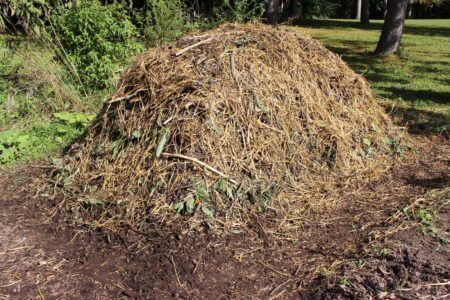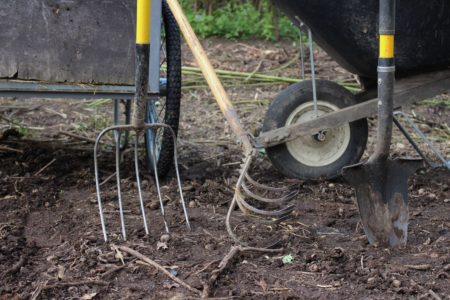Compost Pile
It looks like a pile of straw, but it’s really a very structured compost pile. I built it over the weekend. It’s layered and there is actually not that much straw in it.
My raw ingredients included a pile of two seasons worth of garden debris – weeds, stalks, trimmings and anything else organic collected around the yard and garden that was not super woody. It was mostly already broken down and partially composted. I had a completely broken down 55 gallon drum of household scraps, which was now only about 40 gallons, full of worms, and no stink left. I had a huge collection of recently pulled still green weeds, consisting mostly of galinsoga (quickweed), which I’m letting become my weed of choice in the garden. I had a couple small square bales of rotting straw, lots of stalks of sunchokes or Jerusalem artichokes, and finally, comfrey, which I harvested and layered in as I was building the pile.
I made a platform of soil with raised up edges. The base of the pile is 6 feet by 10 feet. Then I started layering everything. We had just finished a couple weeks of very rainy weather so I didn’t add any water, it was wet enough. My first layer was sunchoke stalks, followed by a layer of compost, followed by green material, either weeds or comfrey. After the pile was about 18 inches tall, I began working in layers of straw. Between each layer of straw, green material or stalks was a layer of compost or partially composted soil. As I was building the pile, I walked on top of it to compress it, trying to keep the pile as square as possible and leave no gaps or air pockets.
I ended up with a very dense pile almost 4 feet tall. I put a lot of straw on the top layer so it would shed water. By the time I finished, the pile had already begun to heat up and this morning most of the lower half of the pile had reached a temperature of 85 F., so I’m not worried about it breaking down. It will cook very quickly.
Compost Pile Tools
Here’s a picture of the tools I used to make the pile. The garden cart was used to haul straw, the wheel barrow used to haul garden debris. The manure fork is a most perfect compost fork for tossing everything but loose soil. The small pointed “SpearHead” shovel is better than a wider traditional spade for slicing into soil and moving a lot of soil without wearing yourself out.
And my favorite tool, the antique five-tined cultivating hoe, was used to clean the ground to prep the pile bed, rip apart debris, and loosen compacted soil. It would have been a lot more difficult without it. This tool will let me easily keep the paths around the pile weed free.
Compost is the key to successful gardening and is the safe and sustainable approach to garden nutrition. One doesn’t need an elaborate pile like this. Compost as they say, just happens, by letting organic material break down, but the process can be sped up and the finished product made more usable when a structured system like this is used.


